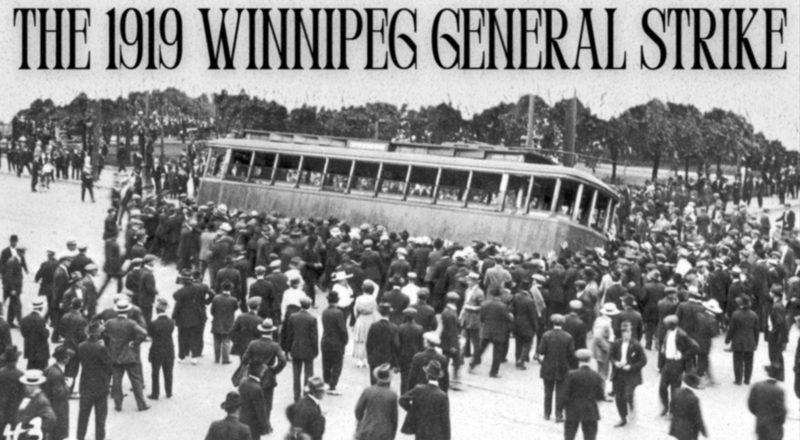
/ Blog
January 9, 2019
The 1919 Winnipeg General Strike: Walker Theatre Meeting Sets the Stage
As 2019 marks the 100th anniversary of the 1919 Winnipeg General Strike, Heritage Winnipeg is commemorating the year by looking back at the events during this tumultuous period of history that helped shape our city. The 1919 Winnipeg General Strike was the largest general strike in Canadian history, with nearly the entire working population of Winnipeg, about 30,000 people, taking to the streets in protest. Starting May 15th, 1919 and lasting until June 25th, 1919, the Strike crippled the city as people from all walks of life joined forces. Frustrated by unemployment, inflation, poor working conditions and regional disparities after the First World War, workers from across the country soon joined in with their own solidarity strikes.
Although the Strikers were mainly peaceful and orderly, the reaction of the employers, city council and the government was aggressive. This aggression led to the Royal North-West Mounted Police attacking gathering Strikers on Saturday, June 21st, 1919 at Main Street and William Avenue. The day is now remembered as “Bloody Saturday”, when two protesters were killed, 30 wounded and many arrested. Fearing further violence, Strike leaders called for the Strike to end. Workers won little with the Strike, with many having no job to return to and waiting another 20 years before collective bargaining was recognized in Canada. A hundred years later, Heritage Winnipeg believes it is a fitting opportunity of promote greater public awareness of the people and the sacrifices they made to improve working conditions for everyone.
There were two very visible events that fed the view that the Winnipeg 1919 Strike was a political revolt, not merely a union protest. One was an important December 22, 1918 meeting at the Walker Theatre (now the Burton Cummings Theatre at 364 Smith Street), organized by the Winnipeg Trades and Labour Council and the Socialist Party of Canada. It was “dedicated to the purpose of finding no good at all in the government.” The meeting was planned because the workers realized that the Trades and Labour Congress officers were “impotent in the matter of securing from the Government redress of the grievances complained of, and were determined that the voice of protest should be heard.” (Defense Committee 1920:4)
The 1,700 workers at the meeting were protesting the use of Orders-in-Council (Dominion Cabinet orders) to deal with issues they believed parliament should have responsibility for. They believed Orders-in-Council were undemocratic in suppressing union action, limiting freedom of the press and curtailing political party activity. The meeting was also a protest against the continued imprisonment of political prisoners and sending military forces to fight the revolutionary government of Russia. The meeting endorsed a resolution (copied from a similar Toronto meeting),”that conditions in this country do not, and never have warranted such an unjustifiable interference with the liberties of the people. We view with apprehension the introduction of autocratic methods and the increasing tendency of a few men to usurp the prerogatives of the people which are alone vested in their elected representatives.” (Defense Committee 1920:7)
A heated discussion took place on a resolution criticizing the dominion government’s use of this form of executive regulation. “Whereas, we, in Canada, have the form of Representative Government; and, whereas, Government by Order-in-Council takes away the prerogative of the people’s representatives, and is a distinct violation of the principles of democracy, therefore, we, citizens of Winnipeg, in mass meeting assembled, protest against Government by Order-in-Council, and demand the repeal of all such orders, and a return to a democratic form of Government” (Defense Committee 1920:11).
The Defense Committee account of that meeting went on to elaborate. “The Order-in-Council is a negation of all that we have fought for and obtained for centuries. We do not propose for one moment to sacrifice those liberties—not for one moment. It is true that we have had a world-wide war. It is true that the capitalist class of the world has fastened upon the rising democracies chains which bid fair to stay, and unless we rise to the occasion and break them, the Labor movement throughout the world will forever be in bondage” (Defense Committee 1920:11).

Source: Manitoba Free Press, December 31st, 1918 (public domain)
The report on the meeting in the Western Labor News of December 27 noted that John Queen, “then called for three cheers for the Russian Revolution. The meeting ended with deafening cries of ‘Long live the Russian Soviet Republic! Long live Karl Liebknecht [a German Socialist who was murdered by nationalist troops the following January]! Long live the working class!’ The meeting ordered that, if possible, the message of congratulations be cabled to the Bolsheviki.”
A follow up meeting at the Majestic Theatre, organized by the SPC, reiterated the critique of government made at the Walker, but laid on more of the socialist critique of government. Despite these meetings, there was never a formal alliance between the unions in the strike and any political party. However in the next year when 30,000 workers went on Strike, this meeting and the speeches by labour activists were used to prove a revolution was being planned.
Dennis Lewycky’s video about the Walker Theatre Meeting.
This article is the first in a series of guest posts reflecting on the 1919 Winnipeg General Strike. Read all the blogs in this series from the beginning:
Walker Theatre Meeting Sets the Stage
Population Growth and the Canadian Pacific Railway Station
The Western Labour Conference in Calgary
Breaking Point – Contract Negotiations Stall
The Strike Shuts Down Winnipeg
Veterans Protest With and Against the Strike
Specials and Strikers Riot
Raids and Arrests
Bloody Saturday
Russell Sedition Trial
THANK YOU TO THE SPONSOR OF THIS BLOG POST:

Guest post written by Dennis Lewycky.
Edited by Heritage Winnipeg.











